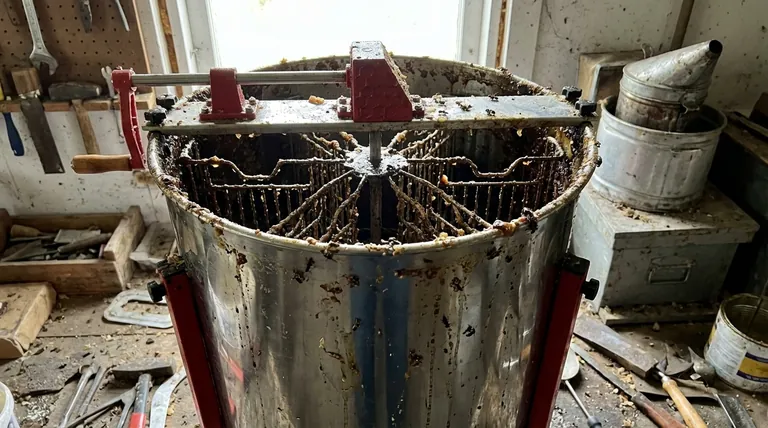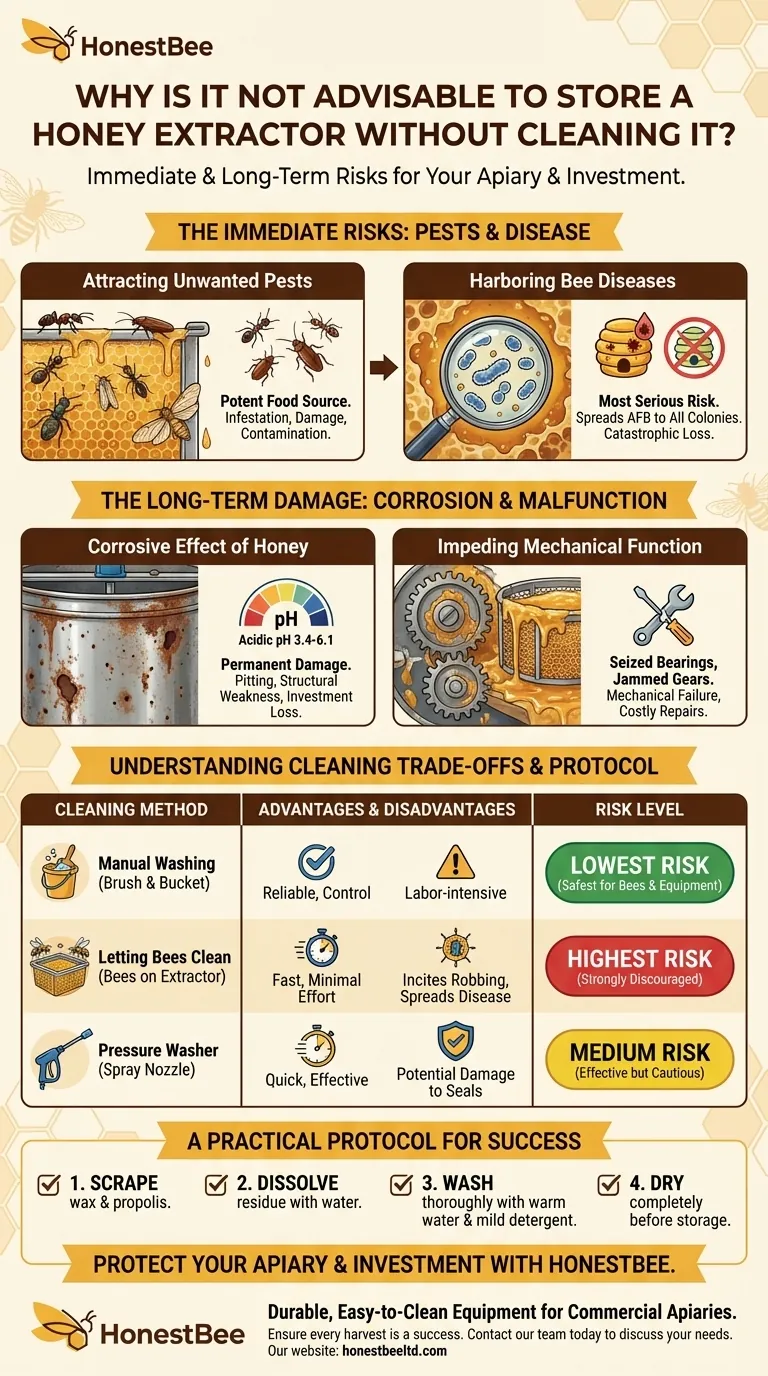Storing a honey extractor without cleaning it is a significant oversight that creates immediate and long-term problems. The leftover honey residue is a powerful attractant for pests, and its acidic nature will actively corrode the machine's components over time. Most critically, an uncleaned extractor can become a vector for spreading devastating diseases throughout your apiary.
The core issue extends beyond simple stickiness or attracting ants. An uncleaned extractor risks permanent damage to your equipment from corrosion and harbors pathogens that can compromise the health of your bee colonies and the quality of all future honey harvests.

The Immediate Risks: Pests and Disease
Failing to clean your extractor after use introduces immediate threats to your equipment and your bees. These risks materialize quickly and can have cascading consequences.
Attracting Unwanted Pests
Honey is a potent food source. Even small amounts of residue left in an extractor will attract pests like ants, cockroaches, and wax moths.
An infestation can be difficult to eradicate and may damage the extractor's smaller components, not to mention creating a significant contamination issue for the next season.
Harboring Bee Diseases
This is the most serious risk. Residual honey, wax, and propolis can contain microscopic spores of bee diseases, most notably American Foulbrood (AFB).
If these spores are present, using the contaminated extractor next season will systematically spread the disease to every colony whose honey you process. This single oversight can lead to the loss of multiple healthy hives.
The Long-Term Damage: Corrosion and Malfunction
Beyond the biological risks, storing a dirty extractor causes physical damage to the machine itself, reducing its efficiency and shortening its lifespan.
The Corrosive Effect of Honey
Honey is naturally acidic, with a pH typically ranging from 3.4 to 6.1. When left on metal surfaces for months, this acidity begins to corrode the extractor.
This corrosion is especially damaging to stainless steel welds and any non-stainless steel components. Over time, it can lead to pitting and structural weakness, permanently damaging your investment.
Impeding Mechanical Function
Wet honey residue will eventually dry and crystallize into a hard, cement-like substance. This hardened honey can seize bearings, jam gears, and prevent the basket from spinning freely.
Come next season, you may spend hours trying to free a mechanism that has been gummed up, and in some cases, the strain can cause mechanical failure.
Understanding the Cleaning Trade-offs
There are several methods for cleaning an extractor, each with distinct advantages and disadvantages. Choosing the right one depends on your tolerance for risk and the effort you're willing to invest.
The Standard Practice: Manual Washing
This is the most reliable and recommended method. It involves scraping out excess wax, then using warm water, a mild detergent, and rags or soft brushes to thoroughly clean all interior and exterior surfaces.
This gives you complete control over sanitation, ensuring all residue is removed. While it is the most labor-intensive approach, it is also the safest for your bees and your equipment.
The High-Risk Shortcut: Letting Bees Clean It
Some beekeepers place the extractor outdoors to let their bees "rob out" the remaining honey. This method is fast and requires minimal effort from the beekeeper.
However, it carries an extremely high risk. It can easily incite a "robbing frenzy" that weakens colonies and, more importantly, will rapidly spread any latent diseases from the extractor's residue to all participating bees. This practice is strongly discouraged unless you are absolutely certain all of your colonies are disease-free.
The Power Method: Using a Pressure Washer
A pressure washer or a trip to a self-serve car wash can remove caked-on honey and wax very quickly.
The downside is the potential for damage. High-pressure water can harm delicate seals, bearings, and welded seams if not used with caution. It is an effective but blunt instrument that requires careful application.
A Practical Protocol for Your Extractor
Proper cleaning is a non-negotiable step in beekeeping best practices. Following a simple, repeatable protocol will protect your bees and your equipment year after year. First, scrape out as much wax and propolis as possible. Then, use water to dissolve the remaining honey, wash thoroughly, and allow every component to dry completely before reassembly and storage.
- If your primary focus is disease prevention and equipment longevity: Always perform a thorough manual cleaning with warm water and a food-safe mild detergent.
- If your goal is absolute harvest purity: A meticulous manual cleaning is the only way to ensure residue from a previous harvest does not contaminate the next one.
- If you are considering letting bees clean it: Acknowledge you are accepting a significant risk of spreading disease and inciting robbing behavior among your hives.
- If you must use a pressure washer: Use a wide-angle nozzle and a low-pressure setting, keeping the stream away from bearings, seals, and electrical components.
Proper equipment maintenance is not just a chore; it is a cornerstone of responsible and successful beekeeping.
Summary Table:
| Risk Category | Key Consequences |
|---|---|
| Immediate Risks | Attracts pests (ants, wax moths); Harbors bee disease spores (e.g., American Foulbrood). |
| Long-Term Damage | Honey's acidity corrodes metal parts; Crystallized honey seizes bearings and jams mechanisms. |
| Cleaning Method | Risk Level |
| Manual Washing | Lowest Risk - Safest for bees and equipment. |
| Letting Bees Clean | Highest Risk - Can spread disease and incite robbing. |
| Pressure Washer | Medium Risk - Effective but can damage seals if misused. |
Protect Your Apiary and Your Investment with HONESTBEE
An unclean honey extractor is a liability that can lead to catastrophic disease outbreaks and costly equipment failure. Don't let a simple maintenance step compromise your entire operation.
At HONESTBEE, we supply durable, easy-to-clean beekeeping supplies and equipment designed for the rigorous demands of commercial apiaries and distributors. Our wholesale-focused operations ensure you get the reliable tools you need to maintain the highest standards of apiary health and honey purity.
Ensure every harvest is a success. Contact our team today to discuss your equipment needs and keep your business thriving.
Visual Guide

Related Products
- 6 Frame Manual Stainless Steel Honey Extractor Beekeeping Equipment
- HONESTBEE 72 Frame Industrial Electric Honey Extractor for Beekeeping
- 40 Frame Commercial Electric Honey Extractor for Beekeeping
- HONESTBEE 6 Frame Three Use Electric Honey Extractor for Beekeeping
- Plastic Hand Crank 2 Frame Honey Extractor Low Price
People Also Ask
- Which type of extractor is more suitable for hobbyists or small-scale beekeepers? Find the Perfect Fit for Your Apiary
- What is the relationship between beeswax harvesting and honey extraction? An Inseparable Process Explained
- What tips can maximize honey extraction efficiency? Unlock Higher Yields and Purer Honey
- What type of honey extractor is best? Maximize Your Harvest Efficiency with the Right Choice
- What is the basic principle of the honey extractor? Harness Centrifugal Force for Efficient Harvesting



















